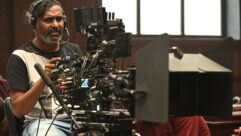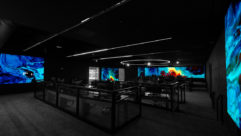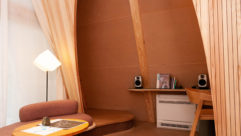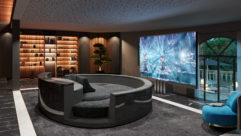In Perfect Taste
Dec 1, 1998 12:00 PM,
Keith Spencer-Allen
As museums race to install as much A-V hardware as possible to enhancetheir exhibits, the task of designing and installing a sound system for awine museum sounds like the ideal job. Although the contents of mostmuseums might suggest how you could best use supporting technology, winetends to mean only one thing in many minds-drinking it. A small, uniqueprojectin the south of France, however, brings to light one specific way inwhich audio may breathe life into subject matter.
Gaillac, a small town in southwestern France, rests in the valley of theRiver Tarn in the foothills of the Massif Central. For many centuries, thishas been wine-growing country, the practice having first arrived with theRomans. The area boasts a microclimate that benefits from its proximity toboth the Atlantic and Mediterranean regions, drawing rain and freshnessfrom the former and warmth and mildness from the latter.
A Benedictine monastery was founded here in A.D. 914, and the developmentof the wine was closely linked to the town itself. The highest navigablepoint on the river that led to the sea at Bordeaux, Gaillac became a focusfor trade. It was also a stopping place for pilgrims en route toCompostello, with the Abbey of St. Michel offering rest, meditation andwine. The Abbey’s cellars by the river were devoted to the production of asparkling wine in a manner that predated champagne. Today, the town isencircled by vineyards. Wineries, numbering in the hundreds, produce a widevariety of wines, many still made by traditional methods, including handpicking under the rules first set by the Benedictine monks.
There are signs of the past wealth of the town. The large, orange-brickAbbey St. Michel sits above the banks of the river in recently restoredsplendor. The cellars and old warehouse areas whose walls fall into theriver still show evidence of practical use. They all form part of thesix-year restoration of the building, and they now are now a part of themuseum of the Abbey, with its collections of old religious items, religiousart, local history and traditions. Since 1996, its long undergroundbrick-lined passages have become La Maison du Vin-the House of Wine andWine Museum.
The large flat areas of the cellars are used for more formal applications,such as a wine-tasting school with rows upon rows of bench spittoons. Themuseum itself is located in the dark, multilevel vaulted tunnels thatpreviously housed the fermentation casks. The wine museum’s section isthree tunnels arranged in a U-shape, each about 30 feet (9 m) long, 12 feet(3.7 m) wide and 8 feet (2.4 m) tall at their highest. Bare, brick-linedwalls and flagstoned floors make this a hard, cold environment.
The designers of the complete museum created a clean and tasteful settingfor their other treasures-beautifully lit and displayed yet totally silent.The wine museum was seen as something completely different, largely due tothe influence of a local organization, Groupe de Musique Electroacoustiqued’Albi-Tarn (GMEA).
Its task was to enhance the value of a wine museum when the displays weresimply historical viticulture tools and equipment. If there had ever been amuseum in need of help from technology, this was it. The bare shape of thetunnels, inanimate nature of the displays and the lack of separationbetween adjacent sections presented difficulties, but GMEA welcomed thechallenge, and also being native, it had a full understanding of wine’simportance in local culture.
The French have always had strong beliefs about almost everything, whichhas kept them distinct from their nearest neighbors for centuries. Onenoticeable attribute is the higher importance placed on sound as a sense.The French government’s Ministry of Culture subsidizes 12 sound researchcenters across France, the best known being Paris’ IRCAM Centre. Mostrelevant here, however, is GMEA, based in Albi, 5 miles (8 km) fromGaillac. It is tasked with research on sound environment and design,composition and the creation of teaching aids.
GMEA, formed by Thierry Besche in 1977, includes among its personnel fivecomposers, a sound engineer, a studio and numerous specialists for itsvarious activities. One of its initial projects was to provide local mapsof the area with an audio cassette that gave the characteristic sounds ofdifferent places on the map, a technique they refer to as “geophony”.Later, this developed into postcards with3 inch (76 mm) CDs carrying otherenvironmental sound themes.
Such activities in this area soon brought them into contact with the wineindustry, arranging annual concerts to celebrate the vin nouveau bycombining sounds of the wine-making process with music, even to the extentof placing the saxophone player in a fermentation vat to explore theinterior acoustics. Another concert, Musique des Vignes, combined soundswith tastes. Composers Thierry Besche and Marc Pichelin created originalwork using recordings made in the vines, cellars and wineries of theGaillac region. These sounds represented different vines and wines, andduring the concert, participants tasted the wines about which they werelistening. GMEA saw this as a direct way of active listening, recognizingthe importance of the sense of hearing. CDs of the work are still sold in apackage with the wine.
With these connections, GMEA was approached to provide the audio contentand handle the complete installation for the proposed wine museum, a taskthey took on readily. Avoiding a traditional museum route, GMEA proposed apoetic interpretation of the various aspects of the Gaillacoisvineyards-vine growing, picking, fermentation, bottling and tasting. GMEAapproached the project as a musical composition that happened to use thenatural sounds of the process as its components. Coupled with the task ofcreating the wine poem was finding a way of making it work in a difficultarea. The first step was to study the space to be used in the museum.
According to Besche, “We had already chosen approximately where we wantedto position the loudspeakers before recording, and through recording,mixing and composing the sound, we were aware of the space we were going tohave to work in. It is really a composition in a space and for that space.”
Engineer Laurent Sassi handled all the field recordings. The content ofeach piece was composed before recording, and the team apparently knew whatthe finished item would sound like. Because of the quality demands, therecording process was handled with great care. A Schoeps stereo mic arrayran via an EAA mixer to DAT. Back in the studio, an Akai D1000 MODworkstation forms the heart of the creation process.
“We call it phonography,” said Sassi. “The recorded sounds are edited andmixed to match the original musical composition. It takes a long time tocreate a natural sound within the framework. We use multilayered sounds anda lot of very small noises, such as insects.”
GMEA used Genelec 1031A active monitor loudspeakers in its studio becauseit found them well suited for such detailed work. GMEA also specifiedGenelec loudspeakers for use within the museum so that the composition waspresented as close to their studio creation as possible. Smaller modelswere chosen; the compact 1029A monitors partnered with 1091A activesubwoofers where needed.
All Genelec loudspeaker models are active. They have their own internalcrossovers and power amps, and they range in size from the compact 1029A,slightly under 10 inches high (254 mm), to the 1035B monitor, weighing 313pounds (141 kg) with a further 156 pounds (70 kg) for the integrated poweramps. A feature of all Genelec monitors is the use of directivity controlwaveguides (DCW), a technique pioneered from the early 1980s in which thecabinet area surrounding the middle- and high-frequency driver componentsis shaped, offering a wide, flat off-axis response, increased driverefficiency and improved stereo imaging.
The 1029As used in the wine museum are two-way systems powered by a pair of40 W amps that drive a metal dome tweeter and a 5 inch (127 mm) bass conedriver. A pair of 1029As can produce peak acoustic levels of 110 dB-SPL at1 m and have a low-frequency response with a -3 dB point at 68 Hz. Thecasing supports rear hanging, an OmniMount size 50 bracket or placement ona mic stand with standard 3/8 inch (9.5 mm) thread. Because theloudspeakers are calibrated out of the box, all the installer has to do isprovide mains power and the input signal via an XLR-type or 1/4 inch jackplug.
For lower response, they can be paired with a 1091A active subwoofer,extending the response down to 38 Hz with an amp rating of 70 W. Itextracts low-frequency signals from the 1029A inputs, and the sensitivitycan be adjusted to allow positioning relative to the stereo loudspeakers.All loudspeakers are finished in black.
For a sound store, GMEA turned to French company RSF. Founded in the mid1970s by Ruben and Serge Fernandez, RSF originally designed and builtsynthesizers. They had worked with Thierry Besche on several musicalprojects and design jobs before, but now it was the range of solid-stateplayback systems that Serge Fernandez was manufacturing under the RSF namethat was of interest. His ProDAP products are designed for museums andother exhibitions where repetitive, high-quality replay is required. Thechosen ProDAP system housed six stereo EPROM cards in a standard 19 inch(483 mm) Euro-Rack to support the six stereo sections. The cards fittedwere the MPEG-2 encoded digital format version, which allowed between 10and 15 minutes of stereo audio to be stored on each.
RSF also supplied the equipment for the audio installation and completed itunder GMEA’s direction. The use of Genelec loudspeakers meant that cablingcould run directly from the ProDAP card outputs to the loudspeakers,bypassing the need for power amps and crossovers. Some high-frequency unitsrequired amplification, which was handled within the ProDAP rack.
The installationAlthough the approximate location of the loudspeakers had been decided atan early date, their precise positioning was handled in an empiricalmanner. The museum designers did not want the loudspeakers to be seen,preferring them to be hidden or placed in boxes. Any such actions wouldhave compromised their performance.
Besche explained, “It was difficult for them to understand that theseloudspeakers need to be seen so that they can work properly. Hiding themwould have defeated the reason for choosing them. They have come around andagree that it works cosmetically.”
The layout of the main display tunnel is for a central walkway withdisplays on either side. They spent four days and nights moving theloudspeakers from one side to another, fine tuning them for their role inthe performance. The majority of the 1029As were wall mounted approximately4 feet (1.2 m) off the ground; in some areas, they are positioned lower andfire up. Most of the stereo images are created on one side or the other ofthe display area, although two are located facing each other across theroom.
The positioning of the 1091A subwoofers was less critical, and for the mostpart, they are placed behind the large display items or in corners near thestereo loudspeakers they support.
A row of four Baker high-frequency units were mounted along the top of theceiling arch, a technique GMEA learned from experience. Besche has likenedthe loudspeaker placement to aiding the sense of where it seems natural forthe sounds to originate.
“The positioning of the loudspeakers was used to express our feelings forthe type of sound being heard,” he said. “In some cases, they werepositioned low when there were sounds that we felt should come from a lowerpoint in the room. In the wine-bottling area where there was a harder,sharper sound, the high-frequency units were used to give height like rainfalling. We have used a combination of the two approaches.”
All wiring to the loudspeakers and ceiling tweeters was placed in brasstubing and mounted on the brick surface. It may be exposed, butcosmetically, it fits well with the character of the old wine-makingequipment.
The tourAs you embark on the wine museum tour, much of what has seemed overlyabstract now makes sense. In the first area where the displays are largelyphotographs of the different vines, information about the soil and thegrowing seasons, a pair of 1029As and a subwoofer are positioned at eitherside of the arch to the next section. Behind you, a large picture windowoverlooks the river, and the sound followsthis theme, creating an ambienceof river sounds punctuated periodically by the tolling of the Abbey belldrawing you into the museum. Entry into this area triggers an IR switchthat starts all the wine museum sound, not just the immediate section. Witheven a low rate of traffic, visitors will pass through the display areasbefore any audio will have switched off.
As you enter the main tunnel, you are immediately in a wash of audio. Thepredominant sound is from the stereo image near you, but you are fullyaware of sound from later stages in the wine-making process further downthe tunnel. The stereo images are wide and distinct; moving in front of adisplay generates a different perspective on the sound. The length of thesound loops has also been carefully chosen such that the average visitor isunlikely to hear repeated sections.
The wine museum has been open for visitors for 12 months. So far, 12,000visitors have passed through, but there are expectations of that number’sincreasing substantially as it becomes a more established landmark. Thereare plans to extend this approach to audio across the whole museum, butthis is not a low-cost option, and it will have to wait for funding.Gaillac has placed an emphasis on quality of presentation because, as yet,the exhibits are not strong enough by themselves. The addition of soundphonography in the wine museum creates an audio experience that Beschesuggests is as important, if not more, than actually seeing the wine-makingequipment itself.
“The way that the sound,” said Besche, “is used brings out images in yourmind that constitute the reality that you would like to see.”
To the staff at the museum and the GMEA team, the link between audio andwine is a given, and the expense of the installation is seen as a naturaltribute to an essential aspect of their culture. There have apparently beenlocal historical links between sound and wine for centuries, which may comeas a surprise, except to the locals.
“In the fermentation of some types of wine,” Besche said. “they use closedbarrels. There were some old guys who didn’t taste the wine, they listenedto it, listening for the bubbles coming up. Through years of experience,they believed that listening was as important as seeing, and a lot ofpeople use that without realizing it. The wine tasters would blend it bytaste, but they were called by the old guys who knew when it was readysimply by listening.”










